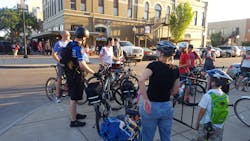Bike Patrol Improves Communications, Fosters Relationships
Though the concept of bicycle policing has been around since the 1800s, the modern renaissance of policing by bicycle is generally attributed to the Seattle Police Department beginning in the late 1980s. “At that time, mountain bikes were just emerging onto the cycling scene, and two officers decided to try them as a solution to the growing traffic congestion hampering response times,” says Maureen Becker, executive director of the International Police Mountain Bike Association (IPMBA). “The mountain bike was a contributing factor because it was the first bicycle practical for the type of riding conditions an officer in an urban environment might encounter.” Results included higher arrest rates and positive public opinion.
Since that time the concept has gained momentum across the U.S. and IPMBA reports 82 to 100 percent of all departments serving populations of 25,000 or more have patrol bicycles.
The present-day benefits of bike patrol are notable. According to IPMBA Instructor David Millican of the Denton Police Department (Texas), one of the founding members for IPMBA more than 25 years ago, bike policing increases an officer’s access and maneuverability within his/her patrol area, promotes faster response times in heavily congested areas, gives officers the ability to ride into and through buildings, move in and around large crowds, almost eliminates foot pursuits and gives a better approach from unexpected areas. “It also increases officers’ awareness of the surroundings and enables them to better hear, see and smell than if they were in a squad car,” he says. Other present-day benefits are cost efficiency, environmental benefits and versatility.
Most importantly, bicycle patrol removes the barrier of the patrol car, making police officers more approachable—a key point in improving police-community relations in recent years.
Removing the barrier
Patrol vehicles can be intimidating as they have heavily tinted glass and are typically moving quickly. “Anyone wanting to talk to an officer has a difficult time getting the officer’s attention or speaking with him casually because the opportunity does not present itself in a patrol car,” says Officer Andrew Humes, College Station Police Department (Texas). Bike officers, on the other hand, are more approachable. “They are typically moving more slowly, can see and hear the surrounding environment much better, and are doing something most people can identify with—riding a bike.”
Since attending the academy, Humes was aware his department had officers assigned to bike patrol and knew they were some of the most active and effective officers on the street. One thing Humes appreciates as a bike patrol officer now is the maneuverability of a bike that lends itself to more opportunities. “When on patrol [in the car] my beat was busy and I often ended up with several reports and many calls for service. I spent very little time talking to anyone who was not at my call or being stopped. Bike officers are able to ride in between or in buildings, on sidewalks, through parks, and almost anywhere else. An officer’s exposure to the community is almost endless,” he says.
Denton PD’s Millican notes that bicycle policing significantly increases positive contacts and non-serious contacts with law enforcement. He points to a 2005 study, which saw an average of 7.3 contacts an hour on bike patrol versus 3.3 contacts an hour for motor vehicle patrol. “This opens the lines of communication between police and community members,” he says. “Officers are seen more friendly and it encourages a more positive interaction with the public.”
Sergeant Van Watson of the Little Rock Police Department (Ark.) has been a community bike officer on and off for two and a half years. He believes the patrol car comes across as a defense to some people, but on the bike, people seem to want to talk to him more. “People are willing to approach us and they’re more comfortable doing so,” he says. “When we’re riding bikes we’ve had community members join us and ride their bikes with us a block or two or even a mile, just to say hi or talk.”
This close proximity to the community they are policing allows bike patrol the opportunity to have casual conversations to know community members and lets the rest of the community get to know the officer, says Humes. “There is no substitute for communication and the bike helps foster this relationship. No matter how modern policing gets, at its heart it is a human endeavor.”
Improved relationships
The aspect of approachability is one big reason police-community relationships have improved in many areas. The 2017 college football season will be Humes’ fifth on bike patrol in the entertainment district in College Station, Texas. Humes recalls that four years ago, his bike patrol unit was booed and the crowd would chant “Let him go! Let him go!” whenever anyone evaded police and was later caught or if the unit arrested anyone for perceived minor violations. “We began a concerted effort to improve relationships with both patrons and employees that worked the district,” he says. “Bikes often started conversations and made us available to anyone who wanted to talk.”Two years later in 2015, Humes recalls that his unit had someone run away from them in a crowded area. The crowd pointed out which direction the suspect was running and made sure they were out of the way as the police gave chase. After a three or four minute sprint through the district they were able to apprehend the suspect in front of a large crowd waiting for rides. There was a short silence after he was handcuffed and then the cheering began. “Several of the regulars were reminding the suspect that no one gets away from ‘their cops,’” says Humes. “While everyone is not our best friend, the bike served as an excellent tool to build relationships and improve the safety of the district.”
Watson tells a similar story. Community members will now come into the resource centers and talk to officers more on a one-on-one basis. “They ask for specific officers that they know and are more willing to tell that officer something because they feel like they have a connection,” says Watson. People know Watson and his bike patrol officers, who never ride solo. “They’ll flag us down and we may spend 30 minutes just talking about their kids but it’s a connection we’ve made with the community.”
Though he doesn’t have statistics on it, Watson has noticed that in the hours that he and his unit are on the bike, crime goes down a little bit. “We’ve noticed that the areas that we’re in on bike patrol, people are more willing to talk to us and relay criminal information to us that we can forward to our other divisions,” he says. This has created a partnership and trust between the police and community. “Our philosophy is that it may take us a little bit longer to solve an issue, but we’re working with the community to help solve the issue—it’s not just a police issue. We’re getting the community involved.”
A commitment for the entire department
Though bicycle patrol has helped mend police-community relations in some areas, this commitment has to be a department-wide strategy. “Community-oriented policing is a commitment for the entire department and it takes many forms,” says Humes. “The officers assigned to a neighborhood or community need to understand the constituency and mission so they can engage the community appropriately.“
Community-oriented policing is the philosophy that the entire Little Rock Police Department has gotten behind. “We at Little Rock PD all believe in community policing where we’re all trying to build a relationship with our community to solve crimes to help our citizens have a better life,” says Watson. “If we can make a difference in one person’s life, that’s all that matters.”
The personal relationships bike patrol officers foster with the community not only increases trust, but strengthens the partnership.

Adrienne Zimmer | Editor
Adrienne Zimmer was the Editor of Law Enforcement Technology magazine, a monthly business-to-business publication that covers technology trends and best practices for public safety managers from 2017 to 2019. LET is part of Officer Media Group, which also publishes Law Enforcement Product News and Officer.com. Adrienne has been in publishing since 2013.




